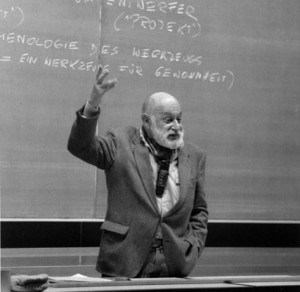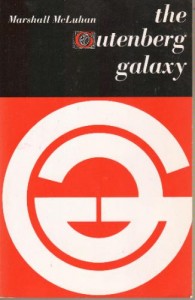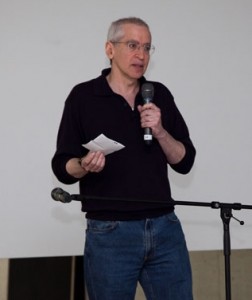Return to Issue 1 Table of Contents
Alan N. Shapiro is the author of “Star Trek: Technologies of Disappearance” and the editor/translator of “The Technological Herbarium” by Gianna Maria Gatti. His small book “Software of the Future” will be published in 2013 by the Walther König Verlag.
Marshall McLuhan believed in a certain historical sequence, an episodic history, a radical break between book culture and the newer electronic era. Before the advent of the phonetic alphabet, humanity was tribal. Gutenberg’s invention of the printing press in the fifteenth century solidified the culture of the written word, thus promoting individualism and democracy. The media age of photography, movies, radio, TV, and something like the World Wide Web (which McLuhan foresaw) “retribalizes” humanity. According to McLuhan’s version of this history, the omnipresent new media and new technologies lead us away from individuality, from the search for self-definition of and by the person, from the “private” experience of reading where each reader is alone with the text and isolated from the vast global network of connections. In the electronic media culture, what counts is “what the group knows.” When an event happens anywhere in the world—a princess in England gets married, a Hollywood star gets drunk and drives, a programmer finds or causes a software application security breach—we all hear about it instantly. The tribal drums beat and we all get the message all of the time. “The new electronic interdependence recreates the world in the image of a global village,” as McLuhan famously said (one of the headlines in The Gutenberg Galaxy). 1 “The globe becomes a very small village-like affair, under electronic conditions,” McLuhan says elsewhere, “in which whatever happens to anybody, happens to everybody.” 2

Vilém Flusser: ©Thilo Mechau, with permission
However, when we start to seriously read the works of another great media theorist, Vilém Flusser, we start to see that McLuhan was, in some ways, incorrect. Flusser presents an alternate historical sequence, one in which an emphasis is placed on the continuity between the culture of written texts (which are both scientific and literary texts) and “the universe of technical images,” as Flusser calls it. I think that Flusser’s version of this history is more accurate or legitimate than McLuhan’s version, even though I still consider McLuhan as a great and very important media theorist. Despite the claims from his followers (and a couple of generations of editors of Wired Magazine) that he was enthusiastic about global wired culture, he was also very critical. Nonetheless, McLuhan’s system lacks a basis for action, a basis that I believe is present in Flusser’s perspective. Flusser provides a conceptual understanding of how we can work towards creating an alternative future, a culture of images, that provides a more conducive framework for human emancipation. The technical image, if treated with awareness, is more a result of scientific and literary texts than we have previously perceived. Technical images are anything but “natural.” When treated without awareness, they tend to be used for manipulative purposes. But without or with awareness, they are related to the texts and to the rational-scientific culture which came before them and which made them possible. With this in mind, two distinctions emerge from these important theorists—Marshall McLuhan: from a tribal culture to a book culture to the reemergence of a tribal culture. Vilém Flusser: the technical image is not a break with the textual-scientific culture.
The present essay is primarily about McLuhan and Flusser, and similar to how they wrote about images very generally, as on the level of the whole civilization, my discussion of the image is painted in very broad strokes. This is different from most contemporary academic discussion about images where one would usually specify which kinds of images one is talking about: scientific images, pornographic images, war images, photoshopped images, sports images, images of Africa, Buddhist images, historical images, generative art, images of paintings, images of nature, images of outer space, family portraits, moving images, digitized images? Other than a section about television studies, I do not get specific in this essay about any category of images. Flusser makes a very general and important point that I think that no other media theorist has made—that what seems to be a “tribal” return to pictorial images before the invention of writing is really the advent of “technical images,” made possible by science and technology. And through this insight, we come to understand that images in the contemporary media culture are much more related to the scientific and literary culture of texts than we have previously perceived or believed. The word and the image resemble each other. And from this discussion about the difference between McLuhan and Flusser’s interpretations of the relationship between the text culture of “the Gutenberg Galaxy” and the electronic culture of images flows a political philosophy and “utopian” discussion about freedom, power, and democracy.

the Gutenberg galaxy
Let us take note of some more of McLuhan’s headlines in The Gutenberg Galaxy: “The portability of the book, like that of the easel-painting, added much to the new cult of individualism.” 3 The media of the book, which promotes a sustained engagement between reader and author, has an elective affinity with democracy. The same can be said about the modern form of painting. The e-book stands in an ambivalent relationship to the book on the question of its contribution to democratic culture. It gains even more in portability, yet loses in solitude and engagement. “Print altered not only the spelling and grammar but the accentuation and inflection of languages, and made bad grammar possible.” (p.231) “Nobody ever made a grammatical error in a non-literate society.” (p.238) If electronic culture brings about a non-literate society, then surely it is furthering the decline of sophisticated language and, concomitantly, of self-expression and individual intelligence. “The reduction of the tactile qualities of life and language constitute the refinement sought in the Renaissance and repudiated now in the electronic age.” (p.240) Media culture and cyberculture positively advance another kind of richness of language: the tactility and nitty-grittiness of slang and vernacular. Yet “the electronic age” has sealed “the entire human family into a single global tribe.” (p.8) In McLuhan, there is both a celebration and a critique of media-electronic culture. In The Global Village: Transformations in World Life and Media in the 21st Century (co-written with Bruce R. Powers), McLuhan writes about how the computer user is reduced to “discarnate information,” a man with no body, no physical location, no name, no identity. “Once placed in relation to the computer … the user is everywhere at once. You are everywhere and so is everybody else using the system.” 4
In a book in the field of television studies that I am writing together with Nolan Bazinet and Nicole Maggio, we consider the 1960s BBC British television show The Prisoner (created, written, directed by, and starring Patrick McGoohan) as a narrative metaphor for understanding the contemporary sociological-technological situation of the hyper-network society. Through The Prisoner, we can understand the successor to the “Surveillance Society” 5 and the successor to “the Global Village” 6. In one sense, McGoohan’s Village is a miniaturized version of Marshall McLuhan’s Global Village. Although most commentators (including Patrick McGoohan himself) have focused on the negative side of The Prisoner as a metaphor for a new form of totalitarianism, we do a “secondary” reading of the “text” of The Prisoner (which becomes our “primary” reading). We see The Prisoner as also bringing out emancipatory possibilities in technoculture. It is an idea of freedom in political theory that is influenced by Michel Foucault, whose theory of freedom is not a liberal theory. Foucault was most well known for his theory and studies of relations of power in modern society. But in “The Ethics of Care for the Self as the Practice of Freedom,” Foucault writes:
“One must observe that there cannot be relations of power unless the subjects are free. If one or the other were completely at the disposition of the other and became his thing, an object on which he can exercise an infinite and unlimited violence, there would not be relations of power. In order to exercise a relation of power, there must be on both sides at least a certain form of liberty.” 7
In contrast to the opposition between power and freedom articulated in liberal political theory, where freedom is generally considered abstractly as being the absence of external constraints imposed by the state or other large institutions/organizations, power for Foucault operates in and through everyday life practices, and the discovery of freedom is to be made in understanding how we have been manipulated in many of the most intimate areas of our personal existence, and how we can concretely and creatively transform that. This liberation is a process of experimentation, and we will never know at the outset of each freedom-forging experience what the outcome is going to be. But the question that really interests us is: how do we accomplish this radical progressive transformation in the age of information and online social media? How do we realize the next step in what something like social media can be?
We are interested in the character of Number 6 in The Prisoner as someone who is practicing freedom in the here and now, creatively overturning and transforming (I think of the French Situationist concept of “le détournement”) the conditions of life which are given to him by the totalitarian “media society” of The Village.
Vilém Flusser, unlike Marshall McLuhan, explicitly demonstrates the liberatory possibilities inherent in the universe of technical images. Flusser was a utopian thinker, in many ways similar in his perspective to the philosopher of I and Thou Martin Buber, touched by the spirituality of Jewish Kabbalah, and having parallels with the Gestalt Therapy of Fritz Perls and Laura Perls. But Flusser’s principal objects of academic-scientific investigation were media and technology. In Into the Universe of Technical Images, Flusser writes about “the prospect of a future society that synthesizes electronic images. Seen from here and now, it will be a fabulous society, where life is radically different from our own.” 8 This utopia is not automatically realized by new media and new technologies (that would be “technological determinism”); it can be realized when media/technologies are developed consciously in utopian directions. “Taking contemporary technical images as a starting point, we find two divergent trends. One moves toward a centrally programmed, totalitarian society of image receivers and image administrators, the other towards a dialogic, telematic society of image producers and image collectors.” (p.4) Totalitarianism or democracy: it is up to us.
Flusser starts out with an historical genealogy of megatrends similar to McLuhan’s: “Linear texts have only occupied their dominant position as bearers of critically important information for about four thousand years … Before that, during the forty-thousand-year period of so-called prehistory, other media—especially pictures—carried this information.” (p.5) Then one might be tempted to say—as McLuhan does in his claim that electronic culture retribalizes humanity—that “we are now in the process of turning back to two-dimensionality, into the imaginary, magical, and mythical.” (p.6) But “the present essay [Into the Universe of Technical Images] intends to show that this view is incorrect. It maintains that technical images are inherently different from early pictures, which will be referred to here as ‘traditional.’ More specifically, technical images rely on texts from which they have come and, in fact, are not surfaces but mosaics assembled from particles.” (p.6) On page 30 of Into the Universe of Technical Images, Flusser expresses his precise disagreement with McLuhan, mentioning him by name. Technical images are a continuation of—not a rupture with—the Western culture of scientific and literary texts, a Fortsetzung by other means.

Alan Shapiro, with permission of author
Technical images are made possible by scientific principles worked up into technologies. Particles in the contexts of specific technologies are assembled or computed into visible images. Each image technology [the photograph, the .JPG image, the VRML-programmed virtual world] is a different way of structuring particles. Calculation and computation are added to the scientific method, and to reading and writing, as fundamental treasures of the Western culture of rationality and progress. “The miracle of calculation followed computation, the miracles to which technical images owe their existence.” (p.24) Technical images are reservoirs of information. Programming is a form of freedom. In the future society of images, everyone will be empowered to “envision.” Everyone will be a programmer and a synthesizer of images. “The photographs, films, and television and video images that surround us at present are only a premonition of what envisioning power will be able to do in the future… All vision, imagination, and fictions of the past must pale in comparison to our images.” (pp.37-38) I think that Flusser is here alluding to something like the coming together of virtual reality environments and stories of high literary quality that Janet Murray wrote about in her book Hamlet on the Holodeck and that I wrote about in my book Star Trek: Technologies of Disappearance. A culture of images that is a continuation of the culture of literature of the past.
The future culture of images implements “a technology of dialogue, and if the images circulated dialogically, totalitarianism would give way to a democratic structure.” (p.171) Flusser also acknowledges the level of participation in such a culture: “There will be an ongoing dialogical programming of all apparatuses by all participants.” (p.154) This is conceived by Flusser as something very existential and very human. “I mean roughly that which Buber called ‘dialogic life’.” (p.154) It will be a playful existence. Flusser mentions homo ludens (p.100), an allusion to the Dutch cultural historian Johan Huizinga and the seminal work that he wrote about “the play element in culture.” “The crucial thing about such a dialogic reordering of society, about this ‘dialogic life’ 9, is its playfulness.” (p.93) Our task is “to grasp the revolutionary possibilities of a telematic society, a true information society.” (p.87) “Such a society, in dialogue through images, would be a society of artists. It would dialogically envision, in images, situations that have never been seen and could not be predicted. It would be a society of players who would constantly generate new relationships by playing off moves against countermoves, a society of Homines ludentes in which inconceivable possibilities would open to human existence.” (p.85) Something like a permanent multi-dimensional chess game.
Part 2 of this essay will appear in Issue 2 of VJIC
Return to Issue 1 Table of Contents
(You are invited to add to the conversation below.)
References
- McLuhan, Marshall, 1962, The Gutenberg Galaxy: The Making of Typographic Man; Toronto: University of Toronto Press. ↩
- Molinaro, Matie, McLuhan, Corinne & Toye, William (eds.), 1987, Letters of Marshall McLuhan; New York: Oxford University Press. ↩
- McLuhan, Marshall, 1962, The Gutenberg Galaxy: The Making of Typographic Man; Toronto: University of Toronto Press: p.206 ↩
- McLuhan, Marshall and Powers, Bruce R., 1989, The Global Village: Transformations in World Life and Media in the 21st Century; New York: Oxford University Press, p. 118. ↩
- Foucault, Michel, 1997, “The Ethics of Care for the Self as the Practice of Freedom” in Ethics: Subjectivity and Truth (edited by Paul Rabinow) (translated by Robert Hurley et al.); New York: The New Press, pp. 281-301. ↩
- McLuhan, Marshall and Powers, Bruce R., 1989, The Global Village: Transformations in World Life and Media in the 21st Century; New York: Oxford University Press. ↩
- Foucault, Michel, 1997, “The Ethics of Care for the Self as the Practice of Freedom” in Ethics: Subjectivity and Truth (edited by Paul Rabinow) (translated by Robert Hurley et al.); New York: The New Press, pp. 281-301. ↩
- Flusser, Vilém, 2011, Into the Universe of Technical Images (originally published in German in 1985 as Ins Universum der technischen Bilder) (translated by Nancy Ann Roth, introduction by Mark Poster); Minneapolis: University of Minnesota Press, p.3 ↩
- Buber, Martin, I and Thou (many editions). German: Ich und Du (many editions, originally published in 1923). ↩
